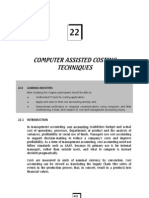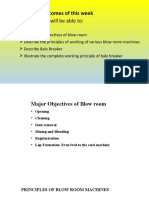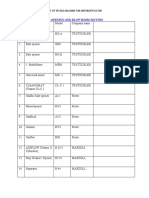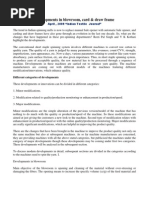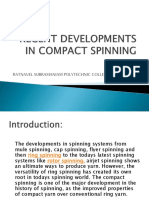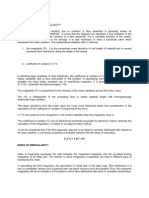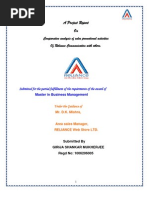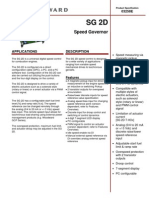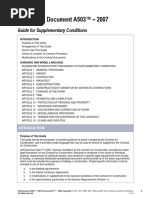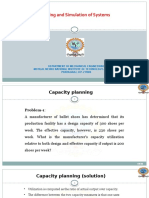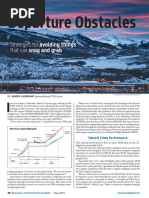Prof Ym
Prof Ym
Uploaded by
Gourav KatyalCopyright:
Available Formats
Prof Ym
Prof Ym
Uploaded by
Gourav KatyalOriginal Title
Copyright
Available Formats
Share this document
Did you find this document useful?
Is this content inappropriate?
Copyright:
Available Formats
Prof Ym
Prof Ym
Uploaded by
Gourav KatyalCopyright:
Available Formats
Prof.Dr. A.
Kirecci
BLOOWROOM - PRODUCT OVERVIEW
Short-staple Spinning
A typical process-line for ring spinning system
The Blowroom
The blowrooom is the first step of yarn production in the spinning mills.
Bales are taken to the blowroom and prepared for the process. Briefly,
basic operations in the blowroom are,
1) Opening
2) Cleaning
3) Dust removal
4) Blending
5) Even feed of material to the card
RIETER BLOOWROOM - PRODUCT OVERVIEW
OPENING
Opening is the first operation within the blowroom in which the goal is always a high
degree of openness of material with gentle treatment and a fiber loss as less as
possible.
OPENING
Type of Opening and Degree of Opening
Two stages of opening must be distinguished.
I. Opening to flocks: in the blowing room.
2. Opening to fibers: in the card and OE spinning machine.
Ways of opening:
1) Breaking up of larger tufts into several smaller tufts to create new surfaces,
2) Opening up of individual tufts to increase the volume.
OPENING
The influence of a fourth or fifth cleaning step in the Hue on the over-all cleaning
efficiency is marginal, but the contribution to fiber loss and quality reduction is
considerably higher.
Hence short cleaning lines with only two or three cleaning points are today's state-
of-the-art. With appropriate machinery design, one pre-cleaner and one or two fine-
cleaners per line are sufficient.
Opening Devices
CLEANING
The cleaning efficiency always has to be optimized and not maximized, since the
fiber quality (short fibers, neps) as well as fiber loss is always negatively affected
by maximum trash removal.
Deduction of Cleanability of Cotton
CLEANING
Cotton contains up to 18% trash; in most cases, this figure lies
between 1 % and 7%.
To clean the material adequately, it is unavoidable to remove at
least as much fiber as waste. Since this loss is a considerable cost
factor, it has to be kept as low as possible, which requires an
assessment.
CLEANING
DUST REMOVAL
An often underestimated task of the blowroom line is the removal of dust.
However, it is as important as the removal of impurities.
Dedusting in the blowroom happens by air suctioning only, either
between the machines, e.g. by dust cages, dust extractors , etc., or within
the machine by normal air separation.
Every blowroom machine must be capable of extracting dust, so that
special dedusting machines should be needed.
The efficiency depends not only on the devices but also on the size of the
flocks. The smaller the flocks, the higher is the efficiency.
BLENDING
Blending of fiber material is an essential preliminary in the production of a yarn.
Fibers can be blended at various stages of the process. These possibilities should
always be fully exploited, for example, by transverse doubling.
However, the starting process is one of the most important stages for blending, since
the components are still separate and therefore can be metered exactly and without
dependence upon random effects.
A well-assembled bale layout and even (and as far as possible, simultaneous)
extraction of fibers from all bales is therefore of paramount importance.
EVEN FEED OF MATERIAL TO THE CARD
Finally, the blowroom must ensure that raw material is evenly delivered to the
cards.
Previously, this was carried out by means of precisely weighed laps from the
scutcher, but automatic flock-feeding installations are now state of the art.
Whereas, in the introductory phase, such installations were subject to
problems regarding evenness of flock delivery, today they generally operate
well.
Quantity of Waste
Rieter indicates average quantities of waste (in %) in the spinning mills of
industrialized countries.
Blending the waste
It will be apparent that raw fibers are usually better than waste fibers because waste contains processed and therefore stressed fibers.
Furthermore, since waste fibers experience different numbers of machine passages, they differ from each other in their characteristics.
For example, lap web is strongly compressed, but waste from thread-break suction systems is barely compressed at all.
Random and uncontrolled feeding of such fiber material back into the normal spinning process is to be avoided at all costs, since considerable count variation will result together with quality variations.
General considerations regarding opening /
cleaning
The degree of cleaning cannot be better than the degree of opening. Dirt
can be removed practically only from surfaces.
New surfaces must therefore be created continuously.
The form of the opening machine must thus be adapted to the degree of
opening already achieved.
The opening devices should become continually finer, i.e. within the
blowroom line, a specific machine required at each position.
The degree of cleaning is linearly dependent upon the degree of
opening.
Newly exposed surfaces should as far as possible be cleaned
immediately.
Ideally the opening and cleaning machines should form unit.
General considerations regarding opening/cleaning
A high degree of opening in the blowroom facilitates cleaning in the carding room.
A high degree of opening out in the blowroom reduces shortening of staple at the
cards.
Opening of cotton on only one opening machine is unthinkable owing to the
degree of opening required.
On the other hand, each machine in the line represent often considerable
stressing of the fibers.
Feeding of flocks in a clamped condition gives an intensive but usually not very
gentle opening action.
Feeding in a loose condition gives gentle, but not very intensive, opening.
Opened flocks should approach as closely as possible a spherical shape. Long
narrow flocks lead to entanglements during rolling movements and pneumatic
transport. Finally, they form neps.
Narrow setting of the feed device relative to the roller increases the degree of
opening, but also the stressing of the material.
BLOWROOM MACHINERY
Since blowroom machines have to fulfill various functions, they vary in
concept and in design. Basically, five types can be distinguished:
1. Opening machines.
2. Mixing machines.
s. Cleaning machines.
a. Dust removing equipment or machines.
5. Recycling machines.
In order to be able to perform their assigned tasks optimally, these
machines must be located at quite specific positions in the blowroom line.
In a normal modem blowroom installation, 4-5 clearly distinguishable
operating zones can be identified
If the cotton is clean and contains only few impurities, then only one
zone of fine cleaning is necessary.
Another variant is that fine cleaning and card feed can form a single
unit.
An additional operation in the blowroom - dust removal -should be
carried out by all machines in the line so as to make special
dedusting machines superfluous. But, if such machines are used,
they appear mostly at the end of the line.
Even when machines within an individual zone differ in design, they
are based on a common basic concept, so that all the machines of a
given zone can in general, be explained by taking one of them as an
example.
Zone 1 Opening Machines
Automatic Bale-opening Machines
The first-generation automatic bale-opening machines were mostly
stationary. Only the bales were moved, either backwards and
forwards or in a circle.
The second-generation machines are of the travelling type , i.e. they
move past the bales of the layout and extract material from top to
bottom.
Automatic bale opening machine UNIfloc A 11 (Rieter)
Raw Material -Cotton and man-made fibers up to 65 mm.
Production400-1400 k/h k/h
Bale Plucking Machine Model LA17/LA28(Lakshmi)
Crossroll Bale Opener
Travelling machines have the advantage that more bales can be processed as
an over all unit (charge), and thus a better long-term blend is achieved.
It should be noted, however, that these machines extract material only in
batches, i.e. they can process only one, two, or at most three bales
simultaneously. If a long-term blend is to be achieved, then mixing machines
must be included downstream from the bale opener.
A bale layout can consist of up to 60 bales from between four and six different
origins, i.e. from four to six different types of bales per fiber blend. Intervening
spaces often have to be left between the individual bale groups so that the
extraction roller can be adapted to varying bale heights.
The machines are completely electronically controlled and extract material
from all bales evenly, independently of varying bale densities. The
machines of this first zone should be able to:
extract material evenly from the bales;
open the material gently;
open up to the smallest flocks;
form flocks of equal size;
process as many bales as possible in a single charge;
be universally applicable, i.e. easy to program;
blend material right at the start of the process; and
permit the putting together of a fiber blend from several components (fiber
origins).
Normal bale openers extract the material from the bales chargewise, i.e. a
certain number of bales are placed in front of the opener and then worked
off and replaced by a new charge of the same number of bales.
Some manufacturers (e.g., Trutzschler) now offer machines of a different
kind, i.e. for a continuous processing of the bales. With this method, the
plucking device of the bale opener is inclined and extracts the material in a
wedge-shaped manner.
The moment the bale at the lowest point of the wedge is completely
exhausted, a new bale at the other end is forwarded into the wedge. The
replacement of the bales goes on one by one continuously and
automatically. In this case, one has to make sure that the average quality
parameters of the blend remain constant.
BLENDOMAT BDT 020 (Tru"tzschier)
Automatic bale openers
BLENDOMAT BDT019 and BLENDOMAT BDT020:
Fiber-saving, even opening
Production rates up to 1,500 kg/hr
Easy operation
Minimal maintenance
Universally applicable
Up to 3 bale groups at the same time
Up to 180 bales in the feed
Feeding up to 3 lines
Lot work-off or continuous bale supply
continuous bale supply
Process visualization
The unifloc of Rieter
In concept, this is currently the most widely used type of machine.
Machines similar to the UNlfloc are built by Marzoli (B 12), and Trutzschler
(Blendomat) among others.
The Rieter UNlfloc enables up to 130 bales arranged per side as four
components (different bale types) per blend over a maximum layout length
of 50 m to be processed. The machine can process one or two blends
simultaneously. The production rate is normally up to 1400 kg/h.
The feed duct (D) and the two guide rails (5) are secured to the floor.
The chassis (A), which moves back and forth on the guide rails, carries a
turret (B), which is rotatable through 1800 and supports a raisable and
lowerable extracting assembly (C).
The latter has individually replaceable double-tooth discs and changes its
direction of rotation on reversal of the direction of movement of the chassis,
so that material can be extracted in both directions of travel.
Zone 2 Machines Pre-cleaning
-they generally process the material while it is in free flight; and
-the striker elements are widely spaced on the operating rollers.
The opening effect is correspondingly small. This is acceptable in zone 2
because an adequate surface area has already been created before that
stage.
These machines are preceded by the bale-opening machines that
form small flocks and thus large surface areas.
The bale-opening machines-themselves cannot clean these surfaces
because they are not fitted with cleaning devices, or, where such
devices are present, they can eliminate only a fraction of the
impurities owing to the high material throughput.
In their basic design, pre-cleaning machines are optimal at their given
position in the line but not at other positions.
The Step Cleaner
The step cleaner is disappearing more and more from the market. In
this machine, the material falls into the feed hopper and passes to the
first beater.
From there, it is transported upwards by the six (sometimes four) beater
rollers, each carrying profiled bars; the beaters are arranged on a line
inclined upwards at 450
The elimination of impurities
takes place during the
continual passage of the
material over the grids
arranged under the rollers.
The grids are always
adjustable, and usually the
beater speed is also
adjustable.
Dual-roller cleaner
An example of the dual-roller cleaner is the B31/1 of Marzoli . Here
again, similar models are offered by other manufacturers. The
machine consists of a large cleaning chamber containing two
drums of 610-mm diameter rotating in the same direction.
A fan downstream from the dual-roller cleaner (e.g. in a condenser)
draws material through the machine by suction.
Owing to the larger size of the chamber in comparison with that of
the suction duct, the suction effect falls away in the chamber.
The exit opening is arranged at a higher level than the infeed
opening. Thus, only the smallest flocks can fly straight through.
Most flocks fall into the region of the drums, where, for purpose of
cleaning, they are fed either once or more frequently over the grid bars
before they can leave the machine. The spikes are arranged in a spiral
on the drums in order to improve the passage of the material.
Single roller cleaner
A large roller equipped with
specially designed pins guides
the raw material several times
over a set of grid bars between
entry and exit , which results in
a high cleaning efficiency.
The material passes
simultaneously through a dust-
extraction system, which results in
a high dedusting effect of the
machine.
The material-guidance system
within the machine is purely
mechanical and independent of the
transportation of air. A vacuum
system with a lock roller below the
machine automatically removes the
waste.
The machine excels in high cleaning efficiencies with the lowest fiber loss.
Zone 3 -Blending Machines
The Mixing Battery
This was once the most common type of mixing, and it is still used. The
mixing battery represents the conventional mode of mixing at the start of
the process, from two to five mixing bale openers operate together;
usually one of these openers is a waste feeder.
A good blend is obtained because each opener can be supplied with a
plurality of bales, and the opened material from all bale openers flows
together onto a common conveyor belt.
Crosrol Blender (4CB/6CB)
Mixing Bale Opener
Model LB 3/4(Lakshmi)
Multiple Mixer
The machine consists of several (from six to eight) chute chambers into
which the material is blown from above.
The chutes are filled successively, and the material is removed from all
chutes simultaneously. This gives a good long-term blend.
Ejection of flocks onto a collecting conveyor is done by take-off and beating
rollers under the chutes. The filling height is held fairly constant by feelers.
Multi-mixer MPM 6
Multi-mixer MCM 6 with cleaner CLEANOMAT CXL
Machines were available with filling heights of 2, 3, and 4 m.
To increase the blending effect of normal chute blenders, some
manufacturers install two blenders in a line, mostly with a cleaning
machine positioned between both. For modern control systems,
these blenders often serve also as a material buffer.
UNImix of Rieter
The machine is made up of three parts: a storage section, an intermediate
chamber, and a delivery section.
Flocks are fed
pneumatically and
simultaneously into six J-
shaped chutes (2),
arranged one behind the
other in the storage
section.
A conveyor belt (3) leads
the stock through the
intermediate chamber to
the take-off unit. The
material columns are thus
diverted out of the vertical
into the horizontal.
Mixer UNImix B 70(Rieter)
Unimix
Model LB 7/3(Lakshmi)
Unimix
Model LB 7/4(Lakshmi)
In addition to a condensing effect, this 900 bend in the material flow
also produces a shift in the timing and spatial distribution of transport
of the fiber packets from the first to the last chute.
This in turn results in
good long-term blending.
Thereafter, as in a
blending opener, material
is extracted from the
intermediate chamber
and subjected to a further
opening step between an
inclined spiked lattice (5)
and an evener roller (7),
giving an additional good
short-term blending.
An optical sensor ensures that only a small quantity of fiber stock is
held in the mixing chamber (6). After the spiked lattice, there is
either a simple pneumatic-suction feed to the next machine or a
cleaning unit. Both blending and cleaning machines are thus
provided in a single piece of equipment
BLOOWROOM Dosage Blender
Zone 4 Fine Cleaning (I) machines
In contrast to the zone 2 machines, those of zone 4 have again to
produce new surfaces, i.e. the cleaning operation must be preceded
by opening.
Zone 4 machines therefore almost always operate with clamp feeds.
Bladed rollers, spiked rollers, or rollers fitted with a coarse saw
tooth are generally used. These are often called horizontal openers
or cleaners.
Crosrol places in its horizontal opener (Three roller Cleaner) three
bladed rollers behind each other in a horizontal line.
With a modern blowroom line, for many types of cotton the fine
cleaning line (I) is no longer required, only fine cleaning (II).
Horizontal Opener B34 of Marzoli
The machine is fed through a cage condenser. The feeding silo
(1) has an adjustable side to vary its capacity according to the
required production and the type of material to processed.
The material, whose level is
controlled by a photocell, is
conveyed through a pair of
grooved feeding rollers (2)
towards the nipping roller
and the feelers.
he speed of the feeding rollers is varied by means of the
potentiometer in order to ensure the constant high yield of the
machine in line with the requirement of the other machines in the
production sequence.
The opening-and-cleaning
box is equipped with a
beater (3) and a grid (4)
fitted with adjustable
blades.
The beater can be porcupine,
three-blade, or of the carding type,
and interchangeable in order to
guarantee maximum versatility for
every process requirement.
In the newly designed B35 cleaner,
the bladed beaters. (porcupine) are
replaced by sawtooth rollers and
the grid bars by knife blades with
carding segments between them.
Crosrol offers a horizontal cleaner
with three bladed beaters in a line.
Zone 5 Machines -Fine Cleaning II
In older installations, this zone was provided by the scutcher in the form
of a Kirschner beater and still may be even in modern lines without a
scutcher.
Alternatively, or possibly in addition to the Kirschner beater, there may be
a saw-tooth or needle roller.
This form of intensive-cleaning zone, with a carding or combing roller,
has been forced on spinners in the past, since cotton stock has become
steadily more contaminated, and the impurities have become
progressively smaller.
Where only one machine is used, the carding roller is preferred
to the Kirschner beater.
In this zone, machines from the individual manufacturers exhibit
many similarities.
Often, they are universal machines, which can be fitted with
different types of opening roller.
As a representative example, the Rieter cleaner will be
described.
Fine Cleaning and Dedusting
Machine UNlflex B 60R of
Rie ter
This machine for the opening,
cleaning, and dedusting of
cotton.
Fine cleaner UNIflex B 60
(Rieter)
Flexiclean
Model LB 5/6(Lakshmi)
A fan in the feeding duct helps to
supply the machine with its raw
material.
A specially designed flip-flop feeding
device (1) forms a homogeneous
wadding in the lamina chute (2) over
the whole length and width.
The dust-laden transport air is
extracted through the lamina chute.
The adjustable depth of the chute
allows for a homogeneous filling
operation to take place according to
the production requirements.
Two drums (3) positioned at the bottom
of the chute extract the material.
One of them is perforated (4) to allow
for additional dedusting. The feeding
roller (5) and the servomotor- controlled
adjustable feeding plate pass the fibers
on to the opening and cleaning unit (6).
By using the operating panel (7), the
nipping point can be adjusted according
to the staple length of the material.
The opening-and-cleaning
cylinder (6) guides the fibers
over a modular grid consisting
of servomotor-adjustable mote
knives (8), and one or two
carding elements. It separates
the rest of the trash intensively
but gently from the material.
The angle of mote knives is also
adjusted through the operating
panel.
By adapting the speed of opening and cleaning rollers, operation
can be adjusted to optimal demands. The clothing of the drum is
adaptable to the required performance.
Adjustments are made via the `cleaning-parameter' field, menu-
driven by using a display and keyboard. The `cleaning intensity'
alters the nipping point and the speed of the opening-and-cleaning
cylinder. By using the `amount-of-waste' field is opened or closed.
The Components of Blowroom Machines
Feed Apparatus
Feed of material to the opening rollers occurs in free flight (gentle but less
intensive treatment of the fibers) or in a clamped condition (intensive but
less gentle treatment).
Free flight requires only a drop chute, suction pipe, or vortex transport from
rollers; a clamped-feed condition demands special machine components.
Basically, feed devices can be distinguished according to whether they
consist of: two co-operating clamping cylinders; a feed roller and a feed
table; or a feed roller and pedals.
Operating with two clamping cylinders gives the best forwarding
motion, but unfortunately also the greatest clamping distance (a)
between the cylinders and the beating elements.
In a device having a feed roller and a table, the clamping distance a can be
made very small. This gives intensive opening.
However, clamping over the entire width is poor since the roller presses
only on the highest points of the wadding.
Thin places in the web can be dragged out of the wadding as a clump by
the beaters.
Where pedals are used, the table is divided into many sections, each
of which individually presses the web against the roller, e.g. via spring
pressure. This gives secure clamping with a small clamping distance
a.
As far as the feed system is concerned, influence can be exerted on
opening and cleaning only via the type of clamping, mainly via the
clamping distance (a) to the opening element.
Opening Devices
The great majority of operating devices in blowroom machines
function as opening devices.
Only in co-operation with cleaning apparatus such as grids, etc.,
can they be made to function as cleaning units.
Consequently, they are designed to operated in both opening and
cleaning machines.
Opening units can be classified as:
endless-path; gripping; rotating assemblies.
Depending on their design, construction, adjustment, etc., these
assemblies exert enormous influence on the whole process.
Endless-path Devices (Spiked Lattices)
Spiked lattices serve as forwarding and opening devices in bale
openers and hopper feeders.
They consist of circulating endless hoses or belts with transverse
bars at short intervals.
The bars are of wood or plastics; steel spikes are set into the bars
at a special angle and at greater or smaller spacing.
Owing to their disposition, inclined lattices usually feed the material
upwards at an angle.
The material is carried along by the spikes penetrating into the raw
material.
Opening is obtained because in the upper region of the lattice there
is a counter-rotating roller, also clothed with spikes and located
fairly close to the lattice.
This roller strips the material from the inclined lattice.
The counter-operation of the two systems of spikes causes the
flocks to be plucked apart.
The intensity of the opening action is dependent upon:
- the distance between the devices;
- speed relationships;
- the total working surface;
- and the number of points.
Spiked lattices are usually located in hoppers.
Since only a small part of the material the smaller flocks can
pass between the very closely spaced spike systems, the greater
part is continually thrown back into the hopper, and this has both
positive and negative effects.
On the one hand, the rotation leads to thorough mixing; on the
other, neps are formed.
Both effects become more marked as the quantity of material in the
hopper increases.
Rotating Devices
I-Rollers with Teeth (Blades) or Spikes
Short, flat, oval, or round iron pegs are welded, riveted or screwed on
the surface of short cylinders.
Flat and oval pegs are secured with the narrow side facing the
direction of rotation.
Various spacing of the striker elements are used.
These devices are incorporated mainly in modem horizontal cleaners,
chute feeds, mixing bale openers, step cleaners, etc., which are located
from the beginning to the middle of the blowroom line.
At the start of the line, the spacing of the striker elements on the roller is
greater; finer spacings are used in the middle (to the end) of the line.
The rollers rotate at speeds in the range of 600-1000 r/min.
II-Drums with Teeth, Small Blades, or Spikes The cylindrical parts are similar to those of the spiked rollers, but they have larger diameters of 600 mm and more. The striking elements are mostly of the same type, though they may differ. In several designs, shafts carrying discs are used in place of cylindrical bodies (porcupine drum).
On their outer peripheries, the discs carry striker noses in the form of
welded or riveted flat bars. The discs are maintained at the desired spacing
by intervening collars.
In all opening assemblies, it is important to avoid removal of material from
the feed batt in strips. For this purpose, the teeth or spikes are usually
staggered to varying degrees.
The spacing of the striker elements on the drums is coarse when the
drum is designed for use at the start of the process (the Rieter UNlclean,
for example) and fine when the drum is designed for use in the middle or
towards the end of the line (for example, as a porcupine cleaner).
Rotation rates range between 400 and 800 r/min, and the device can be
arranged parallel to or at right angles to the material flow.
III-Rollers with Toothed Discs
In contrast to spiked rollers or drums, which have quadrilateral or round
elements, toothed-disc units have noses triangular plucking elements
(coarse sawteeth).
The complete opening device is made up of many such toothed discs
secured to a shaft with an appropriate number of distance pieces. In
this case also, the removal of material in strips is to be avoided.
In toothed discs, the teeth are almost always asymmetrically formed,
since they have to operate in only one direction and therefore rotate in
only one sense.
Automatic bale-opening machines often require alternative
arrangements, since in many cases they move backwards and that is,
the directions of movement and of removal of the material vary.
The material-extracting roller should be sometimes in one direction
and sometimes in the other.
If only one roller is to be used, then it must have symmetrical teeth
that are effective in both directions. This requirement can be satisfied
if the elements are formed as double teeth.(Rieter Unifloc).
Rollers with toothed discs belong in the middle of the blowroom line,
except for those included in bale openers.
IV-Sawtooth Rollers
The impurities have become steadily smaller owing to hard ginning.
If the machine is to eliminate even the smallest particles, then more
flock surface must be created, i.e. the material must be opened to
substantially smaller flocks than before, which is, for that purpose
essential to use sawtooth wire, for example.
However, this roller not only gives the finest opening and the best
cleaning, but it also stresses the fibers most strongly. Setting the speed
of rotation, and other adjustments, demands a `feel' for the operation.
Rotational speeds lie between 600 and 1000 r/min. Sawtooth rollers are
used at the end of the line.
V-Needle Rollers, Pinned Rollers
When processing long-staple and extra-long-staple cottons, the
sawtooth rollers react very aggressively.
Rollers with needles or pins are being used to protect the fibers in
this case.
With medium-staple cottons having a low trash content, the
application of needle rollers is also possible.
VI- Beater Arms (Multiple-bladed Beaters)
Multiple-bladed beaters consist mainly of two or three beater bars
arranged parallel to the supporting shaft and held there by four or
five cast-iron arms.
In the course of one rotation of the shaft, the web projecting from
the feed rollers is subjected to two or three blows over its whole
width. The opening effect, and hence the cleaning effect, is small.
This machine is hardly used today; when it is found at all, it is only
in the form of the double-beater scutcher.
VII-Beaters with Pinned or Needle Bars (Kirschner Beaters)
These machines are similar to the multiple-bladed beaters, but, instead
of beater bars, pinned bars (pinned lags) are secured to the ends of the
cast-iron arms.
The relatively high degree of penetration gives good opening.
Kirschner beaters are therefore often used at the last opening position in
the blowroom line, since good pre-opening of the fiber material enables
gentle opening to be achieved at the taker-in of the card.
The cleaning efficiency of the Kirschner beater is high, but unfortunately
fiber elimination is too hign.
Some machinery manufacturers have therefore replaced the grid under
the Kirschner beater with a guide plate; the resulting machine is an
opener, but no longer a cleaner.
Kirschner beaters comb through the web at speeds of 800-900 r/min.
The Grid
It is the grid or a grid-like structure under
the opening assembly that determines the
level of waste and its composition in
gums of impurities and good fibers.
Grids are segment-shaped devices under
the opening assemblies and consist of
several (or many) individual polygonal
bars or blades (i.e. elements with edges),
and together these form a trough.
The grid encircles at least a quarter, at
most three-quarters, and usually from a
third to a half of the opening assembly.
The grid has a large influence on
the cleaning effect via: the section
of the bars; the grasping effect of
the edges of the polygonal bars;
the setting angle of the bars
relative to the opening elements;
the width of the gaps between the
bars; and the over-all surface
area of the grid.
Elements used in the grids can be;
slotted sheets (a);
perforated sheets (b);
triangular section bars (c);
angle bars (d);
blades (e) (like mote knifes).
Grid Adjustment
Three basic adjustments are possible
- distance of the complete grid to the beater;
- width of the gaps between the bars (a = closed, b = open); and
- setting angle relative to the beater envelope (c = aggressive, b = glancing).
It is seldom possible to make all three adjustments; the machines are
generally so designed that only two adjustment types are possible.
With carding segments, only the distance has to be changed.
LABELS: BLOWROOM
You might also like
- Costing and Quantitative Techniques Chapter 22Document18 pagesCosting and Quantitative Techniques Chapter 22Jones Ola Dan JacobsNo ratings yet
- Product Keys For Autocad 2014Document3 pagesProduct Keys For Autocad 2014maria-LG100% (1)
- Business Plan On Plastic Recycling ManufacturingDocument13 pagesBusiness Plan On Plastic Recycling ManufacturingAmman Abedin100% (4)
- Basic Operations in The BlowroomDocument7 pagesBasic Operations in The BlowroomVikrant KanugondaNo ratings yet
- Tuchler Vs ReiterDocument17 pagesTuchler Vs ReiterUmer IrshadNo ratings yet
- Carding Machine - Operating PrincipleDocument11 pagesCarding Machine - Operating PrincipleNilam Sihar0% (1)
- Blow-Room (Autosaved)Document85 pagesBlow-Room (Autosaved)fekade100% (1)
- Learning Outcomes of This Week: The Students Will Be Able ToDocument24 pagesLearning Outcomes of This Week: The Students Will Be Able ToTalha saeedNo ratings yet
- List of Machine For Opening and Blow Room SectionDocument27 pagesList of Machine For Opening and Blow Room SectionRaj RahadNo ratings yet
- Rieter-A 11 UNIfloc Automatic Bale OpenerDocument3 pagesRieter-A 11 UNIfloc Automatic Bale Openerashik1111007No ratings yet
- Study On Cone WindingDocument18 pagesStudy On Cone WindingNasim Hassan Raj67% (3)
- Cardingmachine 140324082245 Phpapp01Document33 pagesCardingmachine 140324082245 Phpapp01SantoshNo ratings yet
- Shedding DobbiesDocument63 pagesShedding Dobbiesarunmythreyee100% (4)
- Savio Ecopulsars Ei enDocument19 pagesSavio Ecopulsars Ei enAhmed Khallaf50% (2)
- Autoconer Automatic Winding MachineDocument8 pagesAutoconer Automatic Winding MachineAbhay KumarNo ratings yet
- Winding 1Document16 pagesWinding 1Siddhesh Pradhan67% (3)
- LMW Comber Lk69Document16 pagesLMW Comber Lk69Niladri NathNo ratings yet
- Developments in Blowroom, Card & Draw FrameDocument14 pagesDevelopments in Blowroom, Card & Draw FrameRajesh Dwivedi82% (11)
- Compact SpinningDocument16 pagesCompact SpinningShankar V Iyer100% (1)
- Assignment On Uster Tester 6Document4 pagesAssignment On Uster Tester 6ZAyed100% (1)
- Ring Spinning MachineDocument11 pagesRing Spinning MachineNavneet JainNo ratings yet
- Auto ConerDocument34 pagesAuto ConerJai Patel0% (1)
- Calculation of Yarn SpinningDocument4 pagesCalculation of Yarn SpinningMohammed Atiqul Hoque ChowdhuryNo ratings yet
- Yarn Preparation For Weaving IDocument18 pagesYarn Preparation For Weaving IKathirrveluSubramainan0% (1)
- Lap FormerDocument12 pagesLap Formershahadat hossainNo ratings yet
- G 35 Ring Spinning Machine Brochure 2161-v2 en 21541Document20 pagesG 35 Ring Spinning Machine Brochure 2161-v2 en 21541Aizaz ShahNo ratings yet
- Investigation Yarn Count Variation of Ring FrameDocument63 pagesInvestigation Yarn Count Variation of Ring FrameYeasin Arafat100% (1)
- Spinning Prepretory - II 18-19Document51 pagesSpinning Prepretory - II 18-19Sushil Mali100% (4)
- Ring FrameDocument9 pagesRing FrameArabinda ChandNo ratings yet
- Ring FrameDocument5 pagesRing FrameMoinamotiNo ratings yet
- Recent Developments in Compact SpinningDocument17 pagesRecent Developments in Compact SpinningsuganNo ratings yet
- U% & C.V%Document4 pagesU% & C.V%Sabeen JahanzebNo ratings yet
- RSB-D-50 Draw Frame Leaflet 2848-V11 86290 Original English 86290Document2 pagesRSB-D-50 Draw Frame Leaflet 2848-V11 86290 Original English 86290cvmrprakash100% (1)
- Training ReportDocument97 pagesTraining Reportmudit bhargava67% (3)
- F CA-blowroom Lowres MarzoliDocument28 pagesF CA-blowroom Lowres MarzoliAshiqueNo ratings yet
- Spinning Geometry of Ring Spinning MachineDocument19 pagesSpinning Geometry of Ring Spinning MachineSahlu Klemewerk Daget0% (1)
- Eli TwistDocument4 pagesEli TwistparthrajNo ratings yet
- Working Procedure of Comber MachineDocument3 pagesWorking Procedure of Comber MachineRatul Hasan100% (2)
- Process Parameters in DrawDocument5 pagesProcess Parameters in DrawTemesgen RegassaNo ratings yet
- LRTDocument5 pagesLRTAnish ak100% (1)
- Main Contents: Detection of Polypropylene Fibers With USTER Quantum 3Document16 pagesMain Contents: Detection of Polypropylene Fibers With USTER Quantum 3PricopNo ratings yet
- Ring FrameDocument13 pagesRing FrameAnkit Kumar0% (1)
- Mathematics of Yarn IIDocument5 pagesMathematics of Yarn IIRobotrix100% (2)
- This Study Resource Was: Speed FrameDocument9 pagesThis Study Resource Was: Speed FrameRatul HasanNo ratings yet
- Blowroom 2Document27 pagesBlowroom 2Abhi ParamNo ratings yet
- DREF SpinningDocument6 pagesDREF Spinningparthjoshi91100% (1)
- Friction SpinningDocument39 pagesFriction SpinningPåñdît ẞhyãmãñtãk MãñîNo ratings yet
- LMW Speed Frame LF4280 ThôDocument16 pagesLMW Speed Frame LF4280 ThôMY Lê Thị Trà100% (2)
- Uster Quantum ClearerDocument27 pagesUster Quantum ClearerMd. Humayun KabirNo ratings yet
- Rotor SpinningDocument4 pagesRotor SpinningJasmeet SinghNo ratings yet
- Winding Efficiency and CalculationDocument16 pagesWinding Efficiency and CalculationTanzila NusratNo ratings yet
- Compact SpinningDocument11 pagesCompact SpinningAbhinandanNo ratings yet
- Objects of Conditioning Are As FollowsDocument7 pagesObjects of Conditioning Are As FollowssachinnmimsNo ratings yet
- Blowroom Process in CottonDocument6 pagesBlowroom Process in Cottonrolandsalifu124No ratings yet
- Study of Lap Former Machine.Document5 pagesStudy of Lap Former Machine.Naimul Hasan67% (3)
- Spinning Maths-1Document12 pagesSpinning Maths-1tsukuyomi03No ratings yet
- Yarn Setting & ClassimatDocument17 pagesYarn Setting & ClassimatMd. Mamunur RashidNo ratings yet
- Devlopments in Roving FramesDocument6 pagesDevlopments in Roving FramesSEEMA SHUKLANo ratings yet
- Mixing:: Basic Tasks of Blow RoomDocument9 pagesMixing:: Basic Tasks of Blow RoommohitNo ratings yet
- Blowroom TheoryDocument5 pagesBlowroom TheoryRahul raman sahuNo ratings yet
- New Microsoft Office PowerPoint PresentationDocument28 pagesNew Microsoft Office PowerPoint PresentationPorir Meye MeghbotiNo ratings yet
- Blowroom: Basic Operations in The BlowroomDocument3 pagesBlowroom: Basic Operations in The BlowroomIndu VikasiniNo ratings yet
- DataTables Example - Bootstrap 4Document4 pagesDataTables Example - Bootstrap 4Dimas CndraaNo ratings yet
- A Project Report On: Comparative Analysis of Sales Promotional Activities of Reliance Communication With OthersDocument66 pagesA Project Report On: Comparative Analysis of Sales Promotional Activities of Reliance Communication With OthersPrashant KumarNo ratings yet
- Document Title Tube Details Tag Nos. E 031A 02Document2 pagesDocument Title Tube Details Tag Nos. E 031A 02SuryaprakashNo ratings yet
- SG2D Governador de VelocidadeDocument4 pagesSG2D Governador de VelocidadealbertooliveiraNo ratings yet
- 87104A RF SwitchDocument12 pages87104A RF Switchengineer_3No ratings yet
- 2016-2026 - A Curtain Raiser: Automotive Mission PlanDocument3 pages2016-2026 - A Curtain Raiser: Automotive Mission PlanMussab KarjikarNo ratings yet
- Noise Assessment ReportDocument29 pagesNoise Assessment ReportThupten Gedun Kelvin OngNo ratings yet
- Steel Framing TechspecDocument4 pagesSteel Framing TechspecCelestino LucioNo ratings yet
- Product Configuration: 10.11.2016 Test Project / 822 - Test Project PDFDocument2 pagesProduct Configuration: 10.11.2016 Test Project / 822 - Test Project PDFvictordraghiciuNo ratings yet
- Inverter - Training SE PDFDocument146 pagesInverter - Training SE PDFNguyễnVănThiệnNo ratings yet
- Foundation RehabilitationDocument17 pagesFoundation RehabilitationsahilkaushikNo ratings yet
- Chapter 3 Site Supervision and OrganizationDocument11 pagesChapter 3 Site Supervision and OrganizationAttempt FailNo ratings yet
- SQL TrainingDocument154 pagesSQL TrainingchazemobileNo ratings yet
- Tell Me About YourselfDocument21 pagesTell Me About YourselfahmadkamalNo ratings yet
- Guide For Supplementary Conditions Aias076853 PDFDocument22 pagesGuide For Supplementary Conditions Aias076853 PDFmtNo ratings yet
- A 6762 FF 32 Olliver DevelopmentsDocument4 pagesA 6762 FF 32 Olliver DevelopmentsMatthew ClarkeNo ratings yet
- Castor Wheel CatalogueDocument12 pagesCastor Wheel CatalogueimrancenakkNo ratings yet
- Catalogo All Hydraulics LLCDocument15 pagesCatalogo All Hydraulics LLCJav RosalesNo ratings yet
- Is 13095 1991Document15 pagesIs 13095 1991Surendra MalasaneNo ratings yet
- Ais - Chapter 1Document54 pagesAis - Chapter 1LumongtadJoanMaeNo ratings yet
- Recorded Third Circuit Lambert Appeal SUBMISSION Statement As EXHIBIT Re 806 Authentic Original Documents From 1983 To 2006, November 18, 2015Document807 pagesRecorded Third Circuit Lambert Appeal SUBMISSION Statement As EXHIBIT Re 806 Authentic Original Documents From 1983 To 2006, November 18, 2015Stan J. CaterboneNo ratings yet
- Strings MajorDocument247 pagesStrings MajorNishant RoyNo ratings yet
- Wls12c Essentials Exam Study Guide 1595677Document17 pagesWls12c Essentials Exam Study Guide 1595677ElidaNo ratings yet
- 2 - Modeling and SimulationDocument10 pages2 - Modeling and SimulationDivyanshNo ratings yet
- 16- General lifting Plan一般起重作业计划Document2 pages16- General lifting Plan一般起重作业计划imdadullahkhan151No ratings yet
- 2011 Amrita ACMICPCeditorialsDocument26 pages2011 Amrita ACMICPCeditorialsamythdbestNo ratings yet
- Bca Departure Obstacles 2016-05Document7 pagesBca Departure Obstacles 2016-05minoudu09No ratings yet
